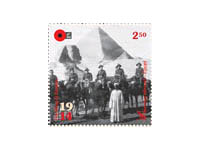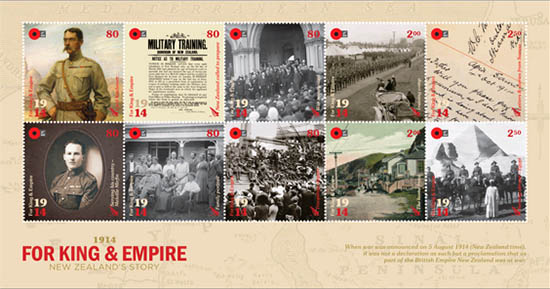
 At 3pm on 5 August 1914, an audience of around 15,000 huddled together in front of the steps of parliament. The crowd excitedly cheered as the Governor, Lord Liverpool stepped forward from a group of his peers. As he made the announcement, you could feel the crowd’s sparks of excitement grow into a roaring flame. Wellington was abuzz with the news that had spread throughout the city – New Zealand was going to war.
At 3pm on 5 August 1914, an audience of around 15,000 huddled together in front of the steps of parliament. The crowd excitedly cheered as the Governor, Lord Liverpool stepped forward from a group of his peers. As he made the announcement, you could feel the crowd’s sparks of excitement grow into a roaring flame. Wellington was abuzz with the news that had spread throughout the city – New Zealand was going to war.
In the coming years of this five-year commemorative programme, we’ll look at the war from a New Zealand perspective. From the front line to the home front, New Zealand was changed forever while this experience began to forge our identity as a confident, stand-alone country.

In 2014, we look at the untold story of New Zealand serviceman and everyman, Melville Mirfin. Like thousands of others, Mirfin left his family behind and answered the call to go to war, but unlike so many soldiers, he not only survived the war, but he survived the action from one end of the war to the other.
 |
80c Lord KitchenerLord Kitchener (Kitchener of Khartoum) is the embodiment of the Empire and its influence in New Zealand in the years leading into World War One. He recommended the withdrawal of New Zealand troops from Gallipoli in 1915, before perishing onboard the HMS Hampshire in 1916. |
 |
80c New Zealand called to prepareThe Defence Act of 1909 was the first step towards compulsory military training, enacted in 1911 (on advice from Lord Kitchener). By 1911, posters such as this one could be seen throughout New Zealand. |
 |
80c War announcedWhen war was announced on the 5th of August 1914 (New Zealand time) it was not a declaration as such, but a proclamation that, as part of the British Empire, New Zealand was at war. |
 |
80c Serving his country – Melville MirfinMelville Mirfin was a bank clerk from a family of seven from Ikamatua on the West Coast of the South Island, who, alongside many others, signed up for war the same week of the proclamation on August 5th. |
 |
80c Family portraitWar inevitably split families across continents and the Mirfin Family is pictured here prior to war, showing all the brothers who would serve and survive. |
 |
80c Troopships departThe Limerick, also known as HMNZT 7, was one of ten troopships in the ‘First Fleet’ that took the NZEF, their horses, and equipment to Egypt in 1914, meeting up with the Australian Imperial Force enroute. |
 |
$2.00 Training campTraining camps such as this one in Canterbury readied troops for the NZEF, destined for Europe (they would instead go to Egypt) before the year’s end. |
 |
$2.00 The home frontKaraka Bay, Wellington, in 1914 – Semi-rural, with some modernity, less than half New Zealand’s population prior to World War One was considered urban, a number that would increase to sixty per cent by the war’s end. |
 |
$2.50 Letters and stories from SamoaNew Zealand’s first duty in World War One was capturing Samoa from the Germans. Melville Mirfin, who had signed up for the NZEF in the first days of August, travelled to Samoa with 1,385 men, during which he would write many times to his family. |
 |
$2.50 Serving abroad – EgyptBy the end of 1914 the first troops of the New Zealand Expeditionary Force had arrived in Egypt for training. For many it was their first time away from New Zealand shores, and they found themselves in front of the Pyramids of Egypt, ready for what was supposed to be the great adventure. |
Technical information
Date of issue: 29 July 2014
Number of stamps: 10 gummed stamps
Stamps and first day covers designed by: Strategy Design and Advertising, Wellington, New Zealand
Denominations: 6 x 80c, 2 x $2.00, 2 x $2.50
Printer and process: Southern Colour Print Ltd by offset lithography
Number of colours: Four process colours
Stamp size and format: 36.95mm x 37.5mm (horizontal)
Paper type: Tullis Russell 104gsm red phosphor gummed stamp paper
Number of stamps per sheet: 24
Perforation gauge: 14.4 x 14.62
Source: New Zealand Post
![]()
